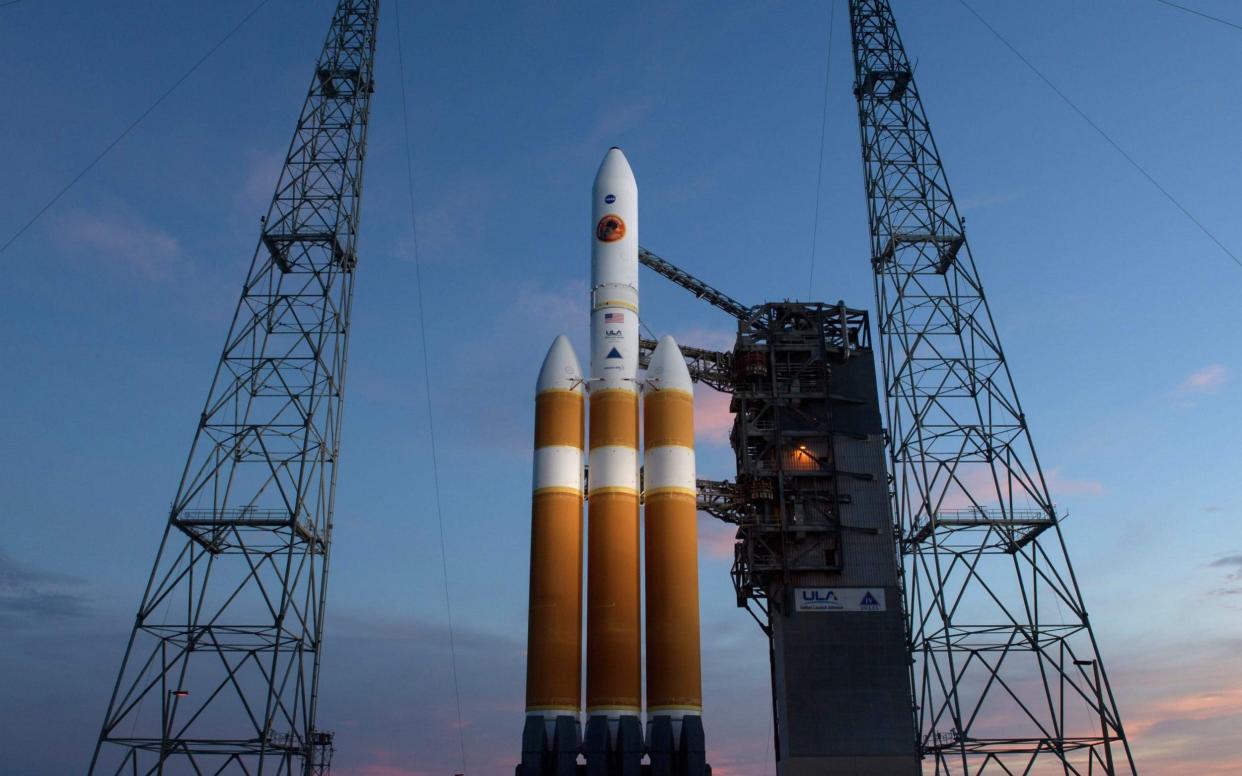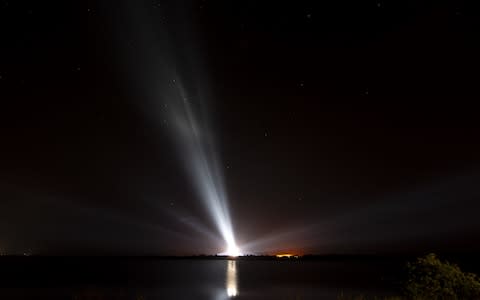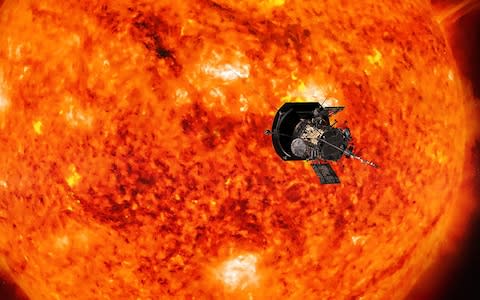Nasa's Parker Solar Probe to launch mission to 'touch the Sun'

Launch from Cape Canaveral, Florida aborted on Sat morning
Nasa to send spacecraft into the Sun's atmosphere
Parker Solar Probe is as heat-resistant as a spacecraft gets
Aim is to make 24 passes through the corona during 7-year mission
Launch aborted
There is clearly still an issue - possibly with the helium regulator.
The launch window has expired and Nasa will now aim to reschedule the launch within 24 hours.
Launch is back on
New launch time set for 9.28am BST (4.29am ET).
No go on launch
The launch has been delayed. It's not clear what the issue is, but there is a "launch window" of around 45 minutes.
The countdown clock was halted at the T-4 minutes.
What are the questions the mission hopes to shed light on?
Magnetic fields
How can the Sun's atmosphere, called the corona, reach temperatures exceeding a million degrees Celsius if the star's surface is "only" 6,000 C (10,800 degrees Fahrenheit)?
"That's the big question: what's heating the solar corona?", said Thierry Dudok de Wit, an astrophysicist at France's National Centre for Scientific Research.
One likely suspect is electromagnetic waves.
Energy is stored in magnetic fields, the thinking goes, that are constantly stirring up the visible surface of the Sun, called the photosphere, and releasing energy into the solar atmosphere.
The FIELDS instrument - which captures the scale and shape of electric and magnetic field - is designed to help scientists figure out how, when, and where that energy release occurs.
Solar wind
Another mystery is how solar wind - composed of ionised gases streaming outward from the Sun at 500 kilometres per second (nearly a million miles per hour) - accelerates.
Finding out would help scientists forecast major space weather events that can adversely impact Earth's magnetic field and, in some cases, change the orbit of satellites and create electrical disturbances.
The solar wind carries a million tons of matter into space every second.
Enter the Solar Wind Electrons Alphas and Protons Investigation (SWEAP), which will count the most abundant particles in the solar wind - electrons, protons and helium ions - and measure their velocity, density and temperature.
"This could help us do a much better job of predicting when a disturbance in the solar wind could hit Earth, triggering space weather that could disrupt GPS, radio, radar and the electric grid," said Justin Kaspar, a professor at the University of Michigan and a principle investigator for the Parker Solar Probe.

Particle acceleration
The Integrated Science Investigation of the Sun (ISOIS) harnesses a pair of instruments to measure the full life-cycle of electrons, protons, ions: where they come from, how they accelerate, how they move out of the Sun through interplanetary space.
"These are high-energy particles that travel at phenomenal speeds approaching the speed of light," said Dudok de Wit.
"They reach Earth" - 150 million kilometres (more than 90 million miles) distant - "in 30 to 60 minutes."
Earth's magnetic shield protects us from these potentially harmful particles, he noted.
"But the day we go to Mars, we'll need to be able to predict solar eruptions of these particles, which can be deadly," he told AFP.
Close up
The Wide-Field Imager for Parker Solar Probe (WISPR) is the only imaging device on board. Never will a camera have come so close to the Sun.
WISPR will look at the large-scale structure of matter spewing outward from the Sun as it approaches the probe, to compliment the detailed physical measurements of other instruments.
NASA scientists know what they are looking for, but have allowed for the element of surprise.
"We have ideas about what will be found, but the most important results may well come from observations that are completely unexpected," said Mark Wiedenbeck, a researcher at the Jet Propulsion Laboratory and part of the ISOIS team.
Night sky is lit up
Light from the xenons on the rocket lighting up the sky as well as we near launch #ParkerSolarProbe#SolarProbe#DeltaIVHeavypic.twitter.com/SuAdIws8Pn
— Sawyer R. (@thenasaman) August 11, 2018
Dr Parker inspected the spacecraft yesterday
What an incredibly special moment to stand in front of @ULALaunch’s #DeltaIV Heavy rocket with Dr. Eugene Parker just hours before his namesake spacecraft - Parker #SolarProbe - launches into space. Something I will never forget. Thanks for the tour @ToryBruno. pic.twitter.com/fTXSeMOJdx
— Thomas Zurbuchen (@Dr_ThomasZ) August 10, 2018
The Parker Solar Probe's projected journey
The Sun's gravitational pull keeps everything in our solar system. Even though the Sun has a powerful pull, it takes 55x more energy to go to the Sun than to Mars! See how our #SolarProbe will make the journey when it launches at 3:53am ET today, Aug. 11: https://t.co/LevTP7RR1bpic.twitter.com/Nv7xHwNDHi
— NASA (@NASA) August 11, 2018
Final preparations ahead of the launch

How and why the Parker spacecraft is so tough
SUPERHERO-WORTHY SHIELD
Parker's lightweight heat shield is just 4 ½inches (11 centimeters) thick. But it can withstand 2,500 degrees Fahrenheit (1,370 degrees Celsius) as well as extreme radiation, thanks to its high-tech carbon. Although the corona reaches millions of degrees, it's a wispy, tenuous, environment and so the spacecraft won't need to endure such severe temperatures. The 8-foot (2.4-meter) shield will face the sun during the close solar encounters, shading the science instruments in the back and keeping them humming at a cool 80 degrees Fahrenheit (27 degrees Celsius). As one scientist notes, this is a shield Captain America would envy.
SEVEN YEARS IN HOT PURSUIT
The spacecraft's path to the sun runs past Venus. It will fly by our solar system's hottest planet seven times over seven years, using the gravity of Venus to shrink its own oval orbit and draw increasingly closer to the sun. The first Venus flyby is in October, followed by the first dip into the sun's corona in November. There will be 24 orbits between Venus and the sun, with the final three putting Parker closest to the sun - just 3.8 million miles (6 million kilometers) out - in 2024 and 2025. That's a scant 4 percent of the 93 million miles (150 million kilometers) between Earth and the Sun.

BREAKING RECORDS
The records will start falling as soon as Parker takes its first run past the sun.. The current close-to-the-sun champ, NASA's former Helios 2, got within 27 million miles (43 million kilometers) in 1976. Parker will come within 15.5 million miles (25 million kilometers) in November and then start beating its own record. During its closest solar approaches, the spacecraft will hurtle through the corona at 430,000 mph (690 kph), setting a speed record.
SOLAR SCIENCE
Our yellow dwarf star is, in many ways, a mystery. The outreaching corona is hundreds of times hotter than the sun's actual surface, confounding scientists. In addition, physicists don't know what's driving the solar wind, the supersonic stream of charged particles constantly blasting away from the sun. By being right in the thick of it, Parker should provide some answers, shedding light not only on our star but the billions of others out there.
PARKER THE MAN
Sixty years ago, a young astrophysicist at the University of Chicago, Eugene Parker, proposed the existence of solar wind. Many were skeptical and told him to read up on it first "so you don't make these killer mistakes," he recalls. Vindication came with NASA's Mariner 2 spacecraft in 1962. Parker is now 91 years old and at Cape Canaveral with his family to witness his first launch - a Delta IV Heavy rocket with the spacecraft bearing his name. It's the first time NASA has named a spacecraft after someone who's still alive. In an interview with The Associated Press on Thursday, Parker noted from a publicity standpoint, "it absolutely wipes out everything else" in his career. "At my age, it gets fatiguing. But of course, I enjoy it."
Nasa to launch mission to the Sun
On Saturday morning Nasa launches a $1.5 billion spacecraft that aims to plunge into the Sun's sizzling atmosphere - marking humanity's first mission to explore a star.
The car-sized Parker Solar Probe is scheduled to blast off on a Delta IV Heavy rocket from Cape Canaveral, Florida at 8.53am BST, with the weather forecast currently 70 percent favourable for takeoff, Nasa said.
By coming closer to the Sun than any spacecraft in history, the probe's main goal is to unveil the secrets of the corona, the unusual atmosphere around the Sun which can cause fierce radioactive storms which threaten Earth.
Not only is the corona about 300 times hotter than the Sun's surface, it also hurls powerful plasma and energetic particles that can unleash geomagnetic space storms, wreaking havoc on Earth by disrupting the power grid.
But these solar outbursts are poorly understood.
"The Parker Solar Probe will help us do a much better job of predicting when a disturbance in the solar wind could hit Earth," said Justin Kasper, one of the project scientists and a professor at the University of Michigan.
Why Nasa's daring mission to 'touch the sun' will be 'the next jump in knowledge'
The probe is protected by an ultra-powerful heat shield that is just 4.5 inches thick (11.4 centimetres).
The shield should enable the spacecraft to survive its close shave with the centre of our solar system, coming within 3.83 million miles (6.16 million kilometres) of the Sun's surface.
The heat shield is built to withstand radiation equivalent up to about 500 times the Sun's radiation here on Earth.
Even in a region where temperatures can reach more than a million degrees Fahrenheit (555,537 C), the sunlight is expected to heat the shield to just around 1,371 C.
Scorching? Yes, but if all works as planned, the inside of the spacecraft should stay at a rather more modest 29 C.
The goal for the Parker Solar Probe is to make 24 passes through the corona during its seven-year mission.

"The sun is full of mysteries," said Nicky Fox, project scientist at the Johns Hopkins University Applied Physics Lab.
"We are ready. We have the perfect payload. We know the questions we want to answer."
The tools on board will measure the expanding corona and continually flowing atmosphere known as the solar wind, which solar physicist Eugene Parker first described back in 1958.
Scientists have wanted to build a spacecraft like this for more than 60 years, but only recently did heat shield technology advance sufficiently to protect sensitive instruments.

Tools on board will measure high-energy particles associated with flares and coronal mass ejections, as well as the changing magnetic field around the Sun.
"We will also be listening for plasma waves that we know flow around when particles move," Dr Fox added.
"And last but not least, we have a white light imager that is taking images of the atmosphere right in front of the Sun."
When it nears the Sun, the probe will travel rapidly enough to go from New York to Tokyo in one minute - some 430,000 miles (700,000 kilometres) per hour, making it the fastest human-made object.

